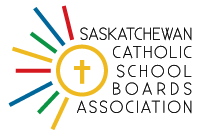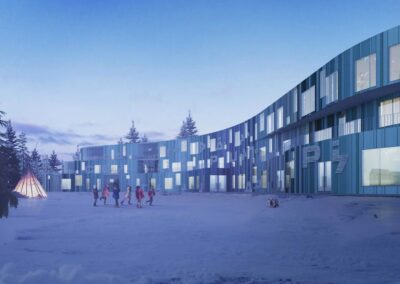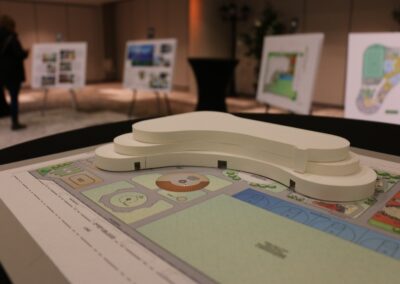Have you ever been invited to go on a trip or journey with a friend? Journeys are usually more enjoyable when you have companions accompanying you along the path. You may not initially see all the opportunities that exist along the path, but you have faith and trust because of your relationship and venture out together. You have each other to celebrate accomplishments along the way, and you help each other through challenging times. You form bonds with new people along the way. Relationships deepen.
In many ways, this is the story of Cree language and cultural programming at St. Frances Cree Bilingual School. Saskatoon Tribal Council (STC) extended the invitation to Greater Saskatoon Catholic Schools to partner and create an educational program to restore Indigenous language, culture, heritage, and identity for First Nations children and youth.
With a bit of uncertainty—mixed with faith and trust—Cree bilingual programming began for kindergarten through Grade 3 students at St. Frances in 2007. The plan mapped out slow and steady growth introducing additional grades each year.
Instruction and programming was purposefully designed to be a learning community with foundations in Cree language and culture. Elders support both teachers and students and integrate traditional Indigenous practices.
Along the way, various partners joined the journey to complement learning. A Professional Development School was established with the Indian Teacher Education Program (ITEP) at the University of Saskatchewan’s College of Education. Medical colleges at the U of S (nursing, dentistry, and medicine) started offering health services and screening that can sometimes be hard to access for First Nations residents.
St. Frances became a school of choice for Indigenous families throughout the City of Saskatoon and surrounding area. Instead of the slow and steady growth that was anticipated, these opportunities to improve programming led to rapid growth. Student enrolment quickly grew from 40 to 600. The 1950s-era school was bulging at the seams, and it became obvious to everyone that a new school facility was sorely needed.
There were no more nooks or crannies to repurpose for learning, no more portable classrooms could be crammed on the small school yard, and space to house these valuable new partnerships was at a premium.
A new or renovated facility became the division’s top capital priority, and talks began in earnest with the Ministry of Education. Year after year, the school remained a top capital priority. No one disagreed it was needed. But approval was delayed.
A dedicated group of parents helped the division’s trustees and administrators, and STC, lobby the provincial government for a new facility. (Watch their story.) As a temporary fix to over-population, Grade 6 – 9 students started going to a different physical location (the former St. Charles School on Bateman Cres.).
In 2017, the school, STC and ITEP were awarded the Premier’s Board of Education Award for Innovation and Excellence in Education from the Saskatchewan School Boards’ Association. (Read the award submission.)
After years of consultations and lobbying, the Government of Saskatchewan’s announcement of funding for a new school facility in 2020 was met with cheers and happy tears. Families would be able to attend a facility worthy of an award-winning program.
Consultations with parents, students, elders, staff and architects began quickly. One thing was certain right from the start: it would be essential that the new school reflect the learning going on within its walls and beyond.
In addition to the traditional aspects of a school that facilitate learning—classrooms, science room, library, gymnasium, a playground, etc.—the physical building is being designed to help to re-establish the continuity of traditional teachings and establish a foundation to strengthen families and communities. Planned aspects include: a child and family wellness centre, the Rotary Indigenous Arts and Identity Program, integrating Indigenous ways of knowing and experiential learning in STEAM (Science, Technology, Engineering, Arts, and Math) areas, an Elders’ teaching room, a medicines lab where students can learn through traditional plant and animal sciences, and a learning greenhouse.
The physical facility itself will be unique as well. Elders, parents, students, and stakeholders visualize a facility and programming that represent what the school stands for through metaphors such as the northern lights, syllabics, and curvilinear design feature.
Cree language and cultural instruction at St. Frances predates the national Truth and Reconciliation Commission (TRC) and its 94 Calls to Action. Restoration of Indigenous heritage, language, culture, and identity has been a goal since its inception. The TRC and Calls to Action give weight to this goal and a framework for the school community—and the entire division—to recognize the truth of historical mistreatment of Indigenous people in our country and work toward restoration and reconciliation.
The physical building that will stand on the corner of Grosvenor Avenue and 7th Street in Saskatoon will be a beacon—a very real and significant sign—of a commitment to healing and renewal. As a soul breathes life into the body, the learning and activity that will happen in it will animate the shell to make it a vibrant community.
The next stage of the journey is scheduled to begin in the summer of 2022, when construction starts, and the opening is planned for the fall of 2024.
To stay up to date on the progress of planning and construction of the new school, visit https://www.gscs.ca/fra/page/5700/new-school-updates
IMG_1180 1200×800
At an open house, students, families and staff review architectural drawings and conceptual images of the new St. Frances Cree Bilingual School.
St-Frances-courtyard-rendering 1200×776
An architectural rendering of what the new St. Frances Cree Bilingual School may look like.
IMG_1130 1200×800
St. Frances Cree Bilingual School students explore different animal hides and footprints at an open house. Traditional land-based learning will be part of the enhanced programming at the new school.
IMG_1213 1200×800
St. Frances Cree Bilingual School students learn coding using programmable Ozobot robots. Use of these and other tools will be part of the STEAM programming at the new school.













